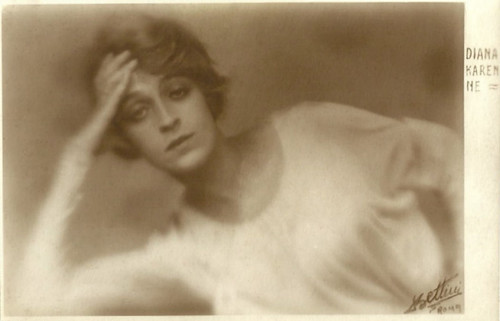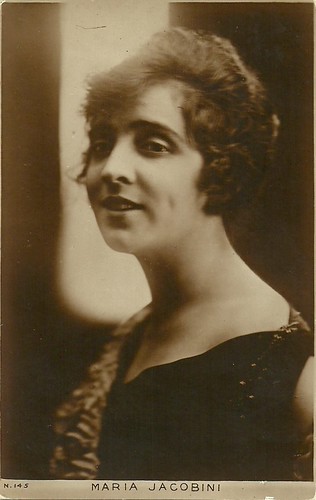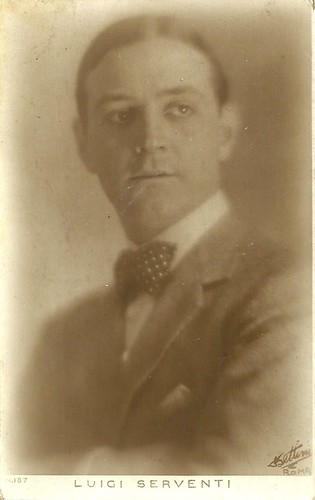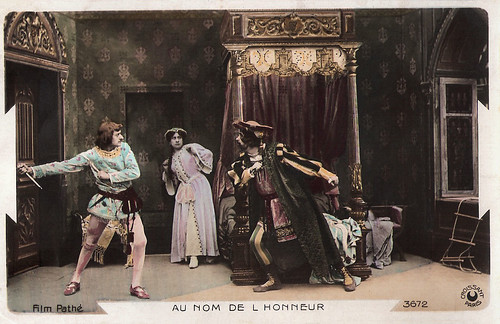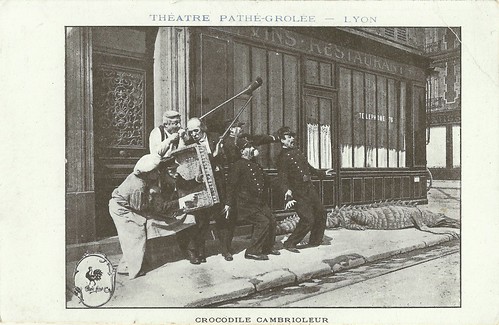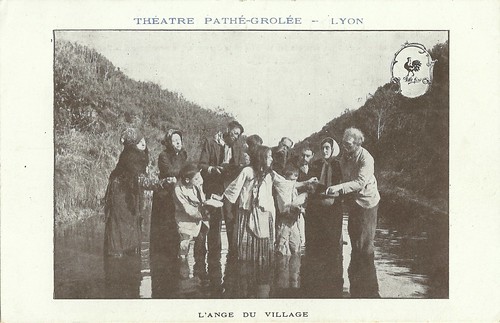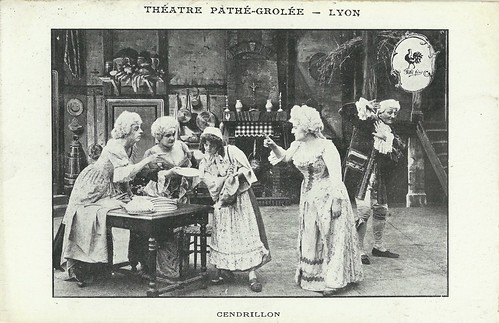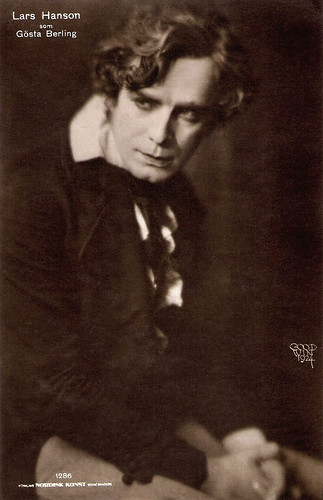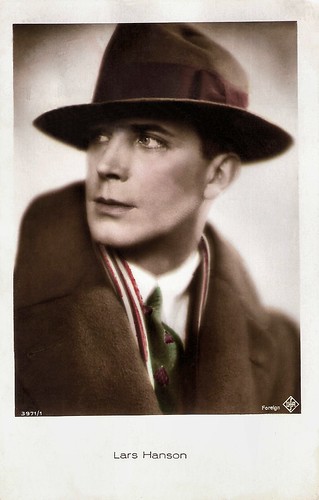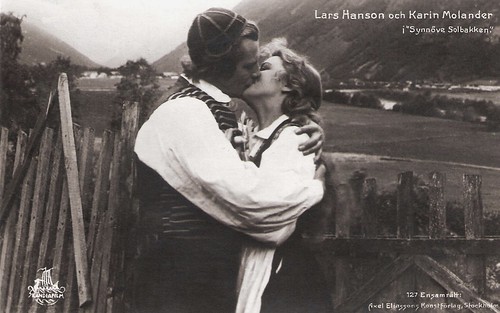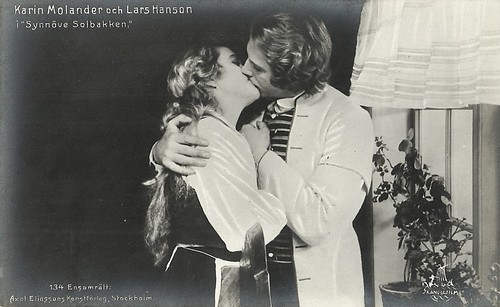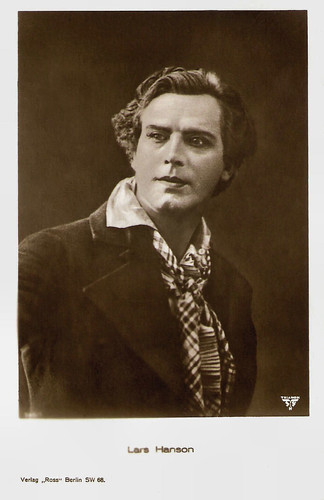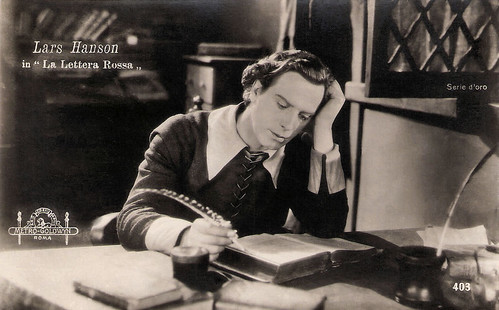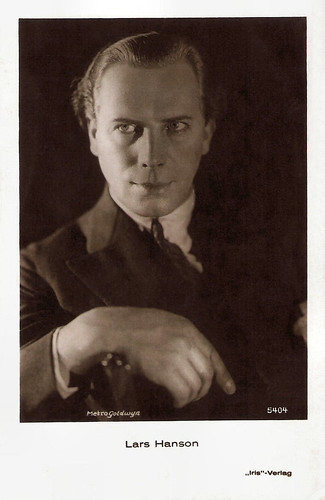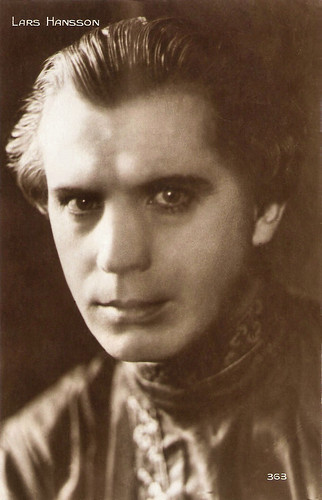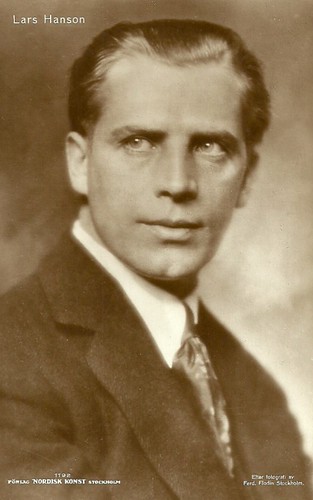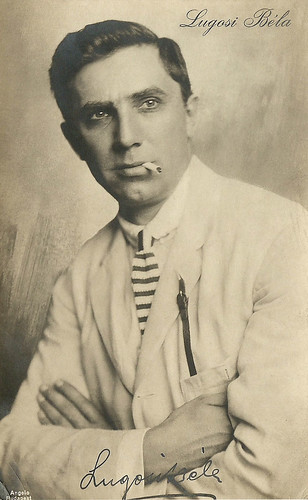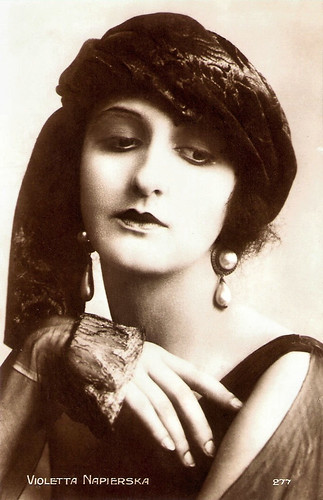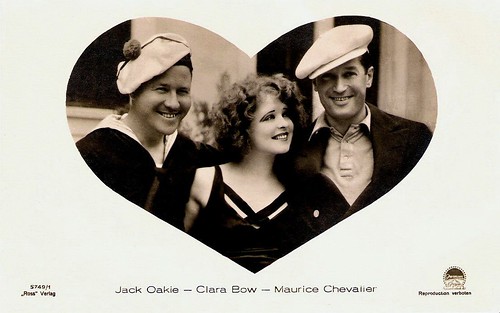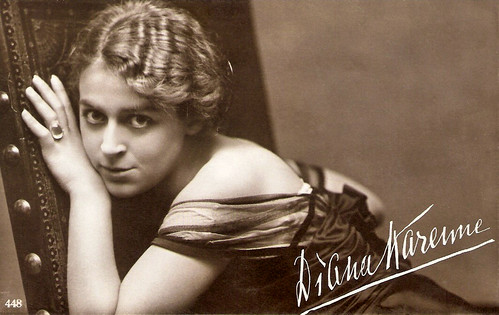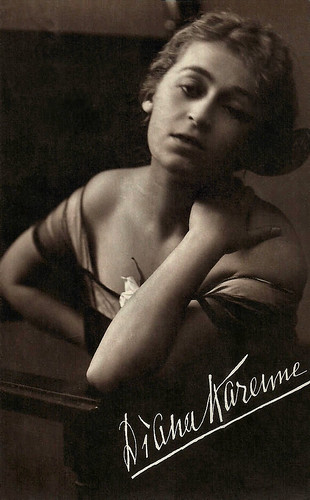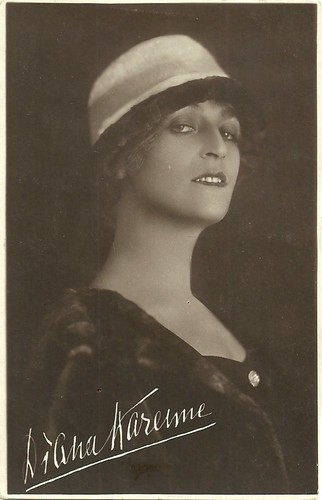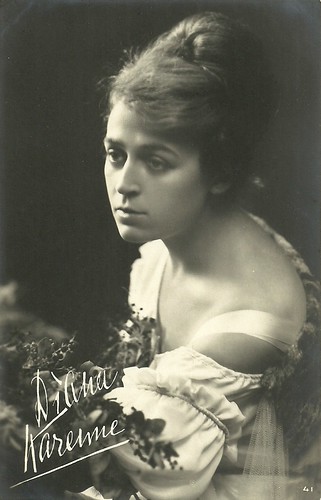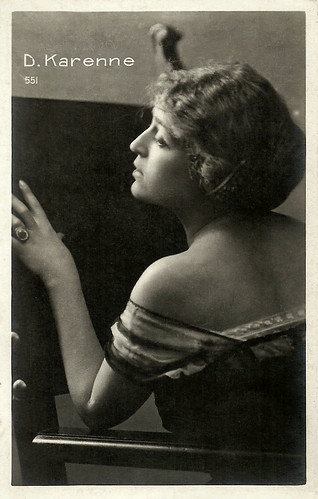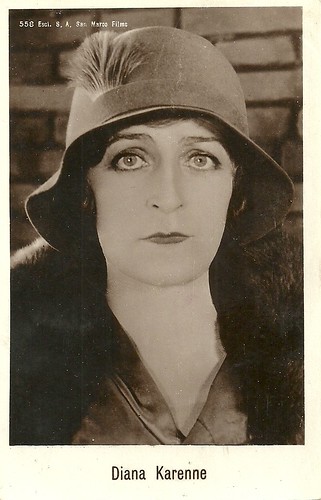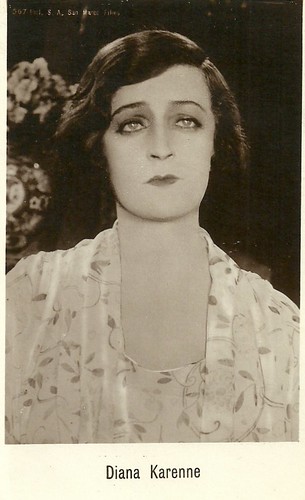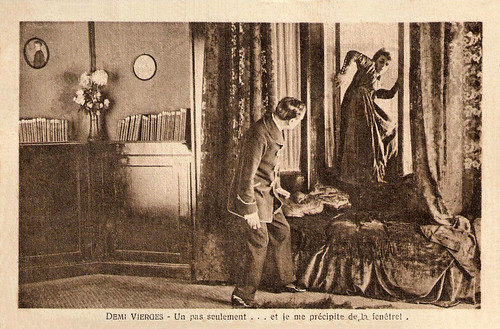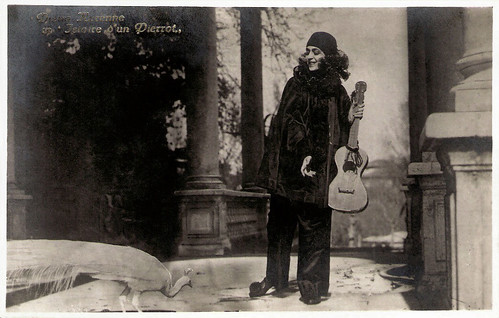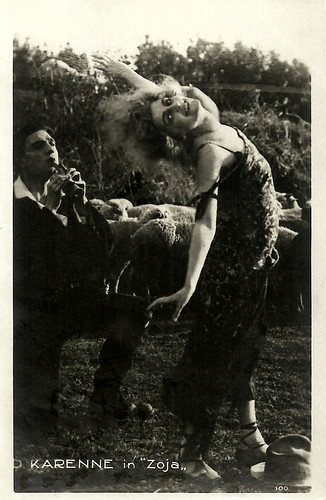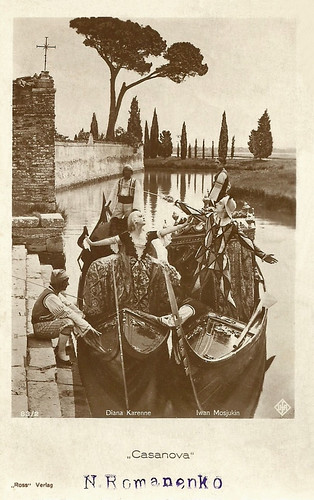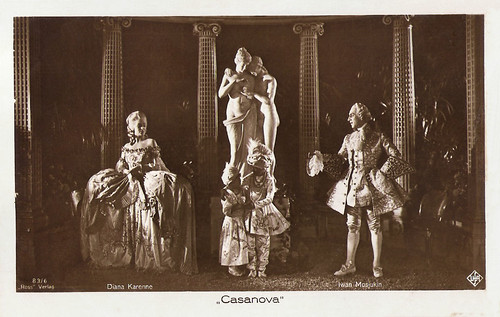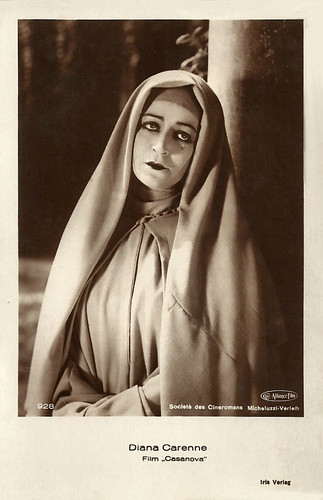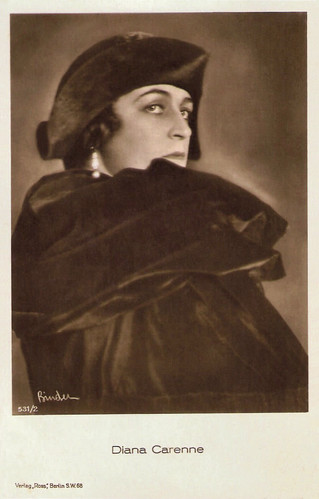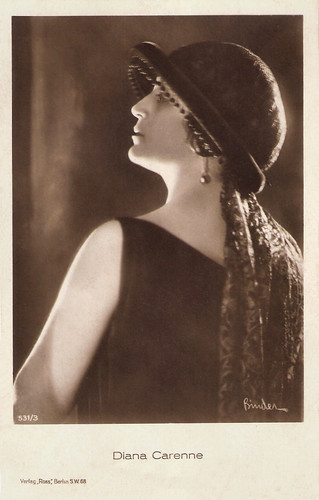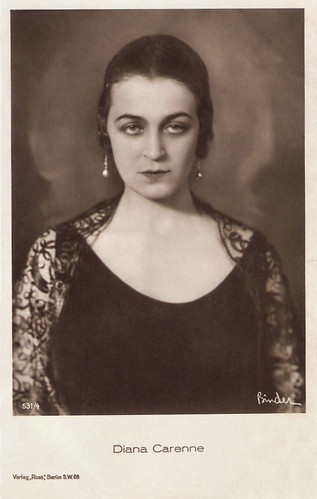Austrian silent film star Mia May (1884-1980) was one of the first divas of the German cinema. During and after the First World War, she became the subject of countless early film star postcards. The rather matronly but graceful actress starred in many silent films of her husband, producer-writer-director Joe May. Her only daughter, the lovely Eva May, committed suicide after a promising film career of her own.
![Mia May]()
German postcard by Rotophot in the Film Sterne series, no. 71/2. Photo: Karl Schenker, Berlin / May Film.
![Mia May]()
German postcard by Ross Verlag, Berlin, no. 259/3, 1919-1921. Sent by mail in Germany in 1921. Photo: Becker & Maass / May Film.
![Mia May]()
German postcard by Ross Verlag, Berlin, no. 429/2 Gr, 1919-1924. Photo: Alex Binder / May Film.
![Mia May]()
German postcard by Ross Verlag, no. 450/5, 1919-1924. Photo: May-Film / Riess.
![Mia May]()
German Postcard by Ross Verlag, no. 450/6, 1919-1924. Photo: Riess / May Film.
![Mia May in Die Herrin der Welt]()
German postcard by Ross Verlag, no. 634/1. Photo: May Film. Mia May and Michael Bohnen in Die Herrin der Welt/Mistress of the World (Joe May and others, 1919).
Mia May was born as Maria Pfleger in Vienna, Austria, in 1884. From the age of 14, she performed on stage under the pseudonym of Herma Angelot.
In 1902 she married Julius Otto Mandl, who lived off the interest of a fortune, inherited from his parents. After their marriage she took a break for some years and we probably never would have seen or heard from her if her husband hadn't lost his whole fortune by speculating unsuccessfully.
For this reason Mia accepted an engagement in Hamburg, where she took part in the operetta Clo-Clo/Clou-Clou. She assumed a new moniker and Mia May sounded good on a marquee. Her husband Julius Mandl followed suit and renamed himself Joe May.
For the long intervals of the operetta Joe made some short films with the actors of Clo-Clo. This paved the way for a new career. In his first film as a director for Continental-Filmkunst GmbH, In der Tiefe des Schachtes/In the Depths of the Shaft (Joe May, 1912), Joe gave his wife the leading part of the beautiful Else.
After that Mia May also played in films by other producers, but her most succesful productions were made by her husband. Their popular screen escapism included Arme Eva Maria/Poor Eva Maria (Joe May, 1916) with Harry Liedtke, and the Joe Deebs detective films featuring Max Landa.
In 1916 she starred in the first film of the Mia May series, Die Sünde der Helga Arndt/The Sin of Helga Arndt (Joe May, 1916). It made Mia a diva of the German cinema, and as Hans J. Wollstein writes at AllMovie: "Mia May rivaled Henny Porten and the great Asta Nielsen in popularity."
![Mia May]()
German postcard by Rotophot in the Film Sterne series, no. 105/5, 1916-1919. Photo: Becker & Maass, Berlin / May Film.
![Mia May]()
German postcard by Rotophot in the Film Sterne series, no. 105/6, 1916-1919. Photo: Becker & Maass, Berlin / May Film.
![Mia May]()
German postcard in the Film Sterne series by Rotophot, no. 106/1, 1919-1924. Photo: May-Film / Becker & Maass, Berlin.
![Mia May]()
German postcard in the Film Sterne series by Rotophot, no. 106/2, 1919-1924. Photo: May-Film / Becker & Maass, Berlin.
![Mia May]()
German postcard by Rotophot in the Film Sterne series, no. 106/3, 1916-1919. Photo: May-Film / Becker & Maass, Berlin.
![Mia May]()
German postcard by Rotophot in the Film Sterne series, no. 106/6, 1919-1924. Photo: May-Film / Becker & Maass, Berlin.
![Mia May]()
German postcard by Ross Verlag, Berlin, no. 258/1, 1919-1924. Photo: Becker & Maass phot. / May Film.
Mia May starred in such films as Hilde Warren und der Tod/Hilde Warren and Death (Joe May, 1917) opposite the later director Fritz Lang as The Dead, and in such popular serials as Die Herrin der Welt/Mistress of the World (Joe May, Joseph Klein, 1919-1920).
The Medieval costume on the postcard immediately above perhaps refers to Veritas vincit (Joe May, 1919), a trilogy in three epochs: Roman Antiquity, the Middle Ages and modern times.
In the historical episodes untruthful antagonists decide upon the tragic destiny of Mia's characters, but in modern times Truth conquers at last when Mia in the end confesses the truth, saving her love played by Johannes Riemann, and defying society. The film was a huge success.
Mia did not only act in the films of her husband, but she also sometimes co-wrote and cut them. At times she also managed May Film.
![Mia May and Hans Mierendorff in Ein einsam Grab (1916)]()
German postcard by Rotophot in the Film Sterne series, no. 93/1. Photo: May-Film. Publicity still for Ein einsam Grab/A lonely grave (Karl Gerhardt, 1916) with Hans Mierendorff.
![Mia May in Die Liebe der Hetty Raymond (1917)]()
German postcard by Rotophot in the Film Sterne series, no. 503/4. Photo: May-Film. Publicity still for Die Liebe der Hetty Raymond/The Love of Hetty Raymond (Joe May, 1917).
![Mia May in Ein Lichtstrahl im Dunkel]()
German postcard by Rotophot in the Film Sterne series, no. 516/2. Photo: May Film. Mia May and Bruno Kastner in the German silent film Ein Lichtstrahl im Dunkel/A Ray of Light in the Dark (Joe May, 1917).
![Mia May and Bruno Kastner in Hilde Warren und der Tod (1917)]()
German postcard by Rotophot in the Film Sterne series, no. 516/3, 1919-1924. Photo: May-Film. Publicity still for Hilde Warren und der Tod/Hilde Warren and Death (Joe May, 1917) with Bruno Kastner.
![Mia May and Bruno Kastner in Der Schwarze Chauffeur (1917)]()
German postcard by Rotophot in the Film Sterne series, no. 516/8. Photo: May-Film / Becker & Maass. Publicity still for Der Schwarze Chauffeur/The Black Chauffeur (Joe May, 1917) with Bruno Kastner.
![Mia May in Wogen des Schicksals (1918)]()
German postcard by Rotophot in the Film Sterne series, no. 527/3. Phoyto: May Film. Mia May in Wogen des Schicksals/Waves of fate (Joe May, 1918).
![Mia May in Fünf Minuten zu spät (1918)]()
German postcard by Rotophot in the Film Sterne series, no. 528/5. Photo:May Film. Publicity still for Fünf Minuten zu spät/Five Minutes Too Late (Uwe Jens Krafft, 1918).
![Mia May in Veritas Vincit (1919)]()
German postcard by Rotophot in the Film-Sterne series, no. 566/1. Photo: May-Film. Publicity still for Veritas vincit (Joe May, 1919). Caption: Veritas vincit. Der grosse Prunkfilm. Szenenbild aus dem I. Teil. Helena, die Tochter des Flavius. (Helena, Flavius' daughter).
![Mia May in Die Herrin der Welt]()
German postcard by Ross Verlag, no. 634/15 Photo: May Film. Mia May and Henry Sze in Die Herrin der Welt/Mistress of the World (Joe May and others, 1919).
Mia May incidentally acted in films made by other directors. Examples are Die Platonische Ehe/Platonic Marriage (Paul Leni, 1919) with Georg Alexander, and Das Wandernde Bild/The Wandering Image (Fritz Lang, 1920) opposite Rudolf Klein-Rogge.
In the twenties her daughter Eva May debuted and took over the leading parts. Mia only played smaller parts in big productions like the two-part adventure epic Das Indische Grabmal/The Indian Tomb (Joe May, 1921).
This mammoth undertaking starred the hypnotic Conrad Veidt, Danish matinee idol Olaf Fönss, and Lya de Putti. The screenplay was written by Thea von Harbou and Fritz Lang.
After Eva's tragic suicide in 1924 Mia retired. In 1933 Mia and Joe, who was Jewish, fled the Nazis. In Hollywood Joe directed several action films for Universal. In 1949 they briefly owned a restaurant, Blue Danube, in West-Hollywood.
Mia May never filmed again. She died in 1980 in Los Angeles.
![Mia May]()
German postcard by Ross Verlag, no. 105/4, 1919-1924. Photo: May-Film / Becker & Maass.
![Mia May]()
German postcard by Ross Verlag, no. 229/2, 1919-1924. Photo: May-Film / Becker & Maass.
![Mia May]()
German postcard by Ross Verlag, no. 230/2, 1919-1924. Photo: May-Film / Becker & Maass.
![Mia May]()
German postcard by Ross Verlag, no. 231/1, 1919-1924. Photo: May-Film / Becker & Maass.
![Mia May]()
German postcard by Ross Verlag, no. 329/1, 1919-1924. Photo: May-Film / Alex Binder.
![Mia May]()
German postcard by Ross Verlag, Berlin, no. 429/1, 1919-1924. Photo: May-Film / Alex Binder.
![Mia May]()
German postcard by Ross Verlag, Berlin, no. 429/4, 1919-1924. Photo: May-Film / Alex Binder.
![Mia May]()
German postcard by Ross Verlag, Berlin, no. 532/6, 1919-1924. Photo: Binder / May Film.
![Mia May]()
German postcard by Ross Verlag, Berlin, no. 533/3, 1919-1924. Photo: May-Film / Alex Binder.
![Mia May]()
German postcard by Ross Verlag, Berlin, no. 533/4, 1919-1924. Photo: May-Film / Alex Binder.
![Mia May in Tragödie der Liebe]()
German postcard by Ross Verlag, Berlin, no. 653/1, 1919-1924. Photo: May-Film. Mia May in Tragödie der Liebe/Tragedy of Love (Joe May, 1923).
![Mia May]()
German postcard by Ross Verlag, Berlin, no. 2001/4. Photo: Becker & Maass / May Film.
Sources: Hans J. Wollstein (AllMovie), Thomas Staedeli (Cyranos), Filmportal.de and IMDb.

German postcard by Rotophot in the Film Sterne series, no. 71/2. Photo: Karl Schenker, Berlin / May Film.

German postcard by Ross Verlag, Berlin, no. 259/3, 1919-1921. Sent by mail in Germany in 1921. Photo: Becker & Maass / May Film.

German postcard by Ross Verlag, Berlin, no. 429/2 Gr, 1919-1924. Photo: Alex Binder / May Film.

German postcard by Ross Verlag, no. 450/5, 1919-1924. Photo: May-Film / Riess.
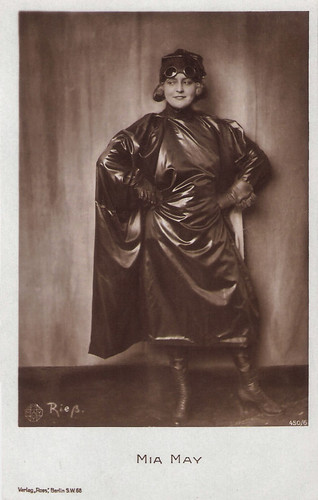
German Postcard by Ross Verlag, no. 450/6, 1919-1924. Photo: Riess / May Film.

German postcard by Ross Verlag, no. 634/1. Photo: May Film. Mia May and Michael Bohnen in Die Herrin der Welt/Mistress of the World (Joe May and others, 1919).
Popular screen escapism
Mia May was born as Maria Pfleger in Vienna, Austria, in 1884. From the age of 14, she performed on stage under the pseudonym of Herma Angelot.
In 1902 she married Julius Otto Mandl, who lived off the interest of a fortune, inherited from his parents. After their marriage she took a break for some years and we probably never would have seen or heard from her if her husband hadn't lost his whole fortune by speculating unsuccessfully.
For this reason Mia accepted an engagement in Hamburg, where she took part in the operetta Clo-Clo/Clou-Clou. She assumed a new moniker and Mia May sounded good on a marquee. Her husband Julius Mandl followed suit and renamed himself Joe May.
For the long intervals of the operetta Joe made some short films with the actors of Clo-Clo. This paved the way for a new career. In his first film as a director for Continental-Filmkunst GmbH, In der Tiefe des Schachtes/In the Depths of the Shaft (Joe May, 1912), Joe gave his wife the leading part of the beautiful Else.
After that Mia May also played in films by other producers, but her most succesful productions were made by her husband. Their popular screen escapism included Arme Eva Maria/Poor Eva Maria (Joe May, 1916) with Harry Liedtke, and the Joe Deebs detective films featuring Max Landa.
In 1916 she starred in the first film of the Mia May series, Die Sünde der Helga Arndt/The Sin of Helga Arndt (Joe May, 1916). It made Mia a diva of the German cinema, and as Hans J. Wollstein writes at AllMovie: "Mia May rivaled Henny Porten and the great Asta Nielsen in popularity."

German postcard by Rotophot in the Film Sterne series, no. 105/5, 1916-1919. Photo: Becker & Maass, Berlin / May Film.

German postcard by Rotophot in the Film Sterne series, no. 105/6, 1916-1919. Photo: Becker & Maass, Berlin / May Film.

German postcard in the Film Sterne series by Rotophot, no. 106/1, 1919-1924. Photo: May-Film / Becker & Maass, Berlin.

German postcard in the Film Sterne series by Rotophot, no. 106/2, 1919-1924. Photo: May-Film / Becker & Maass, Berlin.

German postcard by Rotophot in the Film Sterne series, no. 106/3, 1916-1919. Photo: May-Film / Becker & Maass, Berlin.

German postcard by Rotophot in the Film Sterne series, no. 106/6, 1919-1924. Photo: May-Film / Becker & Maass, Berlin.

German postcard by Ross Verlag, Berlin, no. 258/1, 1919-1924. Photo: Becker & Maass phot. / May Film.
Veritas Vincit
Mia May starred in such films as Hilde Warren und der Tod/Hilde Warren and Death (Joe May, 1917) opposite the later director Fritz Lang as The Dead, and in such popular serials as Die Herrin der Welt/Mistress of the World (Joe May, Joseph Klein, 1919-1920).
The Medieval costume on the postcard immediately above perhaps refers to Veritas vincit (Joe May, 1919), a trilogy in three epochs: Roman Antiquity, the Middle Ages and modern times.
In the historical episodes untruthful antagonists decide upon the tragic destiny of Mia's characters, but in modern times Truth conquers at last when Mia in the end confesses the truth, saving her love played by Johannes Riemann, and defying society. The film was a huge success.
Mia did not only act in the films of her husband, but she also sometimes co-wrote and cut them. At times she also managed May Film.

German postcard by Rotophot in the Film Sterne series, no. 93/1. Photo: May-Film. Publicity still for Ein einsam Grab/A lonely grave (Karl Gerhardt, 1916) with Hans Mierendorff.

German postcard by Rotophot in the Film Sterne series, no. 503/4. Photo: May-Film. Publicity still for Die Liebe der Hetty Raymond/The Love of Hetty Raymond (Joe May, 1917).

German postcard by Rotophot in the Film Sterne series, no. 516/2. Photo: May Film. Mia May and Bruno Kastner in the German silent film Ein Lichtstrahl im Dunkel/A Ray of Light in the Dark (Joe May, 1917).

German postcard by Rotophot in the Film Sterne series, no. 516/3, 1919-1924. Photo: May-Film. Publicity still for Hilde Warren und der Tod/Hilde Warren and Death (Joe May, 1917) with Bruno Kastner.

German postcard by Rotophot in the Film Sterne series, no. 516/8. Photo: May-Film / Becker & Maass. Publicity still for Der Schwarze Chauffeur/The Black Chauffeur (Joe May, 1917) with Bruno Kastner.

German postcard by Rotophot in the Film Sterne series, no. 527/3. Phoyto: May Film. Mia May in Wogen des Schicksals/Waves of fate (Joe May, 1918).

German postcard by Rotophot in the Film Sterne series, no. 528/5. Photo:May Film. Publicity still for Fünf Minuten zu spät/Five Minutes Too Late (Uwe Jens Krafft, 1918).

German postcard by Rotophot in the Film-Sterne series, no. 566/1. Photo: May-Film. Publicity still for Veritas vincit (Joe May, 1919). Caption: Veritas vincit. Der grosse Prunkfilm. Szenenbild aus dem I. Teil. Helena, die Tochter des Flavius. (Helena, Flavius' daughter).

German postcard by Ross Verlag, no. 634/15 Photo: May Film. Mia May and Henry Sze in Die Herrin der Welt/Mistress of the World (Joe May and others, 1919).
Tragic Suicide
Mia May incidentally acted in films made by other directors. Examples are Die Platonische Ehe/Platonic Marriage (Paul Leni, 1919) with Georg Alexander, and Das Wandernde Bild/The Wandering Image (Fritz Lang, 1920) opposite Rudolf Klein-Rogge.
In the twenties her daughter Eva May debuted and took over the leading parts. Mia only played smaller parts in big productions like the two-part adventure epic Das Indische Grabmal/The Indian Tomb (Joe May, 1921).
This mammoth undertaking starred the hypnotic Conrad Veidt, Danish matinee idol Olaf Fönss, and Lya de Putti. The screenplay was written by Thea von Harbou and Fritz Lang.
After Eva's tragic suicide in 1924 Mia retired. In 1933 Mia and Joe, who was Jewish, fled the Nazis. In Hollywood Joe directed several action films for Universal. In 1949 they briefly owned a restaurant, Blue Danube, in West-Hollywood.
Mia May never filmed again. She died in 1980 in Los Angeles.

German postcard by Ross Verlag, no. 105/4, 1919-1924. Photo: May-Film / Becker & Maass.

German postcard by Ross Verlag, no. 229/2, 1919-1924. Photo: May-Film / Becker & Maass.

German postcard by Ross Verlag, no. 230/2, 1919-1924. Photo: May-Film / Becker & Maass.

German postcard by Ross Verlag, no. 231/1, 1919-1924. Photo: May-Film / Becker & Maass.

German postcard by Ross Verlag, no. 329/1, 1919-1924. Photo: May-Film / Alex Binder.

German postcard by Ross Verlag, Berlin, no. 429/1, 1919-1924. Photo: May-Film / Alex Binder.

German postcard by Ross Verlag, Berlin, no. 429/4, 1919-1924. Photo: May-Film / Alex Binder.

German postcard by Ross Verlag, Berlin, no. 532/6, 1919-1924. Photo: Binder / May Film.

German postcard by Ross Verlag, Berlin, no. 533/3, 1919-1924. Photo: May-Film / Alex Binder.

German postcard by Ross Verlag, Berlin, no. 533/4, 1919-1924. Photo: May-Film / Alex Binder.

German postcard by Ross Verlag, Berlin, no. 653/1, 1919-1924. Photo: May-Film. Mia May in Tragödie der Liebe/Tragedy of Love (Joe May, 1923).

German postcard by Ross Verlag, Berlin, no. 2001/4. Photo: Becker & Maass / May Film.
Sources: Hans J. Wollstein (AllMovie), Thomas Staedeli (Cyranos), Filmportal.de and IMDb.


